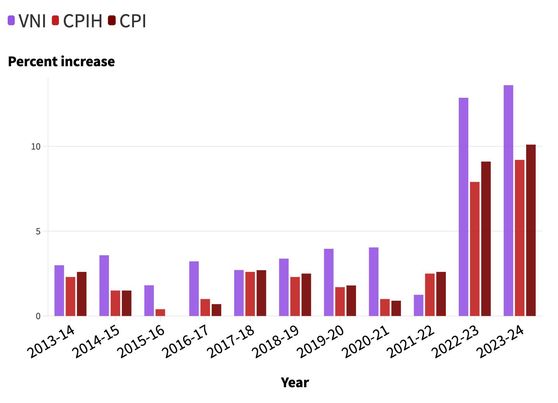The Van Noorden Index, Oxford’s unique inflation index which is often used to inform annual college rent increases, is consistently higher than standard national inflation indices and has recently come under fire for its lack of transparency.
When compared to the national inflation indices calculated by the Office for National Statistics such as the Consumer Price Index (CPI) and the Consumer Price Index including housing costs (CPIH), the VNI trends consistently higher. This holds true for 2022, with the VNI standing at 12.86% versus CPI and CPIH figures of 9.10% and 7.90% respectively. This term, as JCRs negotiate rents for the next academic year, the VNI sits at 13.60% .

Concerns about the VNI have been raised in the SU that there is not enough transparency about the data underlying the VNI. One JCR president expressed their concerns with using the Van Noorden Index to determine rent increases, telling Cherwell: “Using the VNI to calculate rent increases is outdated. It seems to have been consistently higher than other national inflation indexes and fails to consider how students will be able to afford these increases, considering student loan increases are capped at 7%, when over the past two years, the VNI has been 13.60% and 12.86% respectively.”
A Cherwell investigation into rent increases in Michaelmas 2022 found that they ranged between 1.8-12.9%, depending on which college a student attends. The 12.9% hike was from Christ Church, who were using the 2022 VNI figure of 12.86%.
The Van Noorden Index (VNI), a system created decades ago, is named after the late Roger Van Noorden, an economist, fellow, and domestic bursar at Hertford College in the 1970s who is remembered in The Times as “acquiring a daunting reputation for prudence in the college and for financial expertise throughout the university”. The VNI is an inflationary measure unique to Oxford, created to reflect the costs faced by Oxford colleges. It is calculated annually for all colleges by the Estates Bursar Committee, using aggregated cost information and forward forecasts. The VNI is based on the inflation rate of items like utilities, maintenance, and staffing – a narrower set of goods than is used to calculate national inflation indices. In 2020, New College described “the local ‘Van Noorden Index’” as “collegiate inflation” or “in essence service-industry inflation”.
Not all colleges still use the VNI to inform the rents they set for students, with several colleges switching away from the index in the face of high inflation and the cost of living crisis. New College abandoned the VNI as a tool for setting student rent last year when their governing body deemed the 12.86% figure was “too hefty a hike”. Hertford College also stepped away from the VNI last year in favour of the CPI, although they still “recognise the VNI as a useful reference point, and a key local measure”.
Lincoln College has not used the VNI in recent years since they undertook “an analysis of our historic costs” and found a combination of CPI and the Retail Price Index (RPI) “best reflects the inflation in our accommodation costs”. Similarly, St Catherine’s uses its own ‘Full Economic Cost Attribution model’ in discussion with students, and St Hugh’s uses the CPIH. St Hilda’s told Cherwell they do not use VNI because “other indices, such as CPI … are considered to be more relevant”.
However, many other colleges still rely on the VNI to inform rent increases. St John’s College uses the VNI as a “reference point in annual discussions with students to inform the setting of rents and charges”, also taking into account “the balance between College income and expenditure” and available student funding. University College told Cherwell they do not use the VNI “assiduously”, but rather as a “broad-based figure to help guide the College’s budgetary provisioning”. St Anne’s take a more mixed approach, where they “no longer use [the VNI] as the single formal benchmark to set rents”, and instead also incorporate the CPI and other factors like the Real Living Wage, the Oxford Living Wage, and any increases in the maintenance loan levels available to students. Mansfield College simply confirmed that they still use the VNI.
New College bursar David Palfreyman told Cherwell that because the college was not going to use the VNI again this year, it “looks likely that to be another year in which we will under-recover against a further high VNI, costing College a chunky accumulating sum in partially shielding students from the full impact of inflation”.
He argued this would be “a sum most [colleges] will struggle to absorb when they are still recovering from a major hit to revenue streams [rent and conference earnings] during the Covid disruption” and as “they face a doubling of energy costs” amidst frozen tuition fees and market volatility impacting the “prudent draw-down rate from the Endowment”.
Rent negotiations between JCRs and college administrators are ongoing. Rates are expected to be finalised in the coming weeks.
For the full interactive graph visit: https://app.flourish.studio/visualisation/13543070/edit


